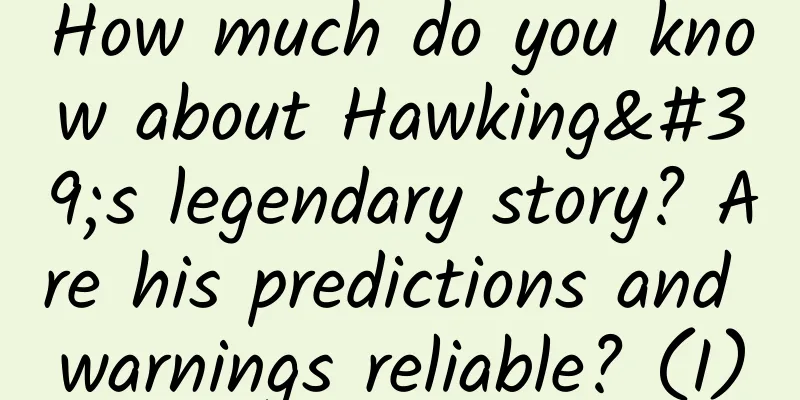31 kinds of comets recorded in great detail? The Han people's "astronomy" achievements are incredible!

|
The vast sky and the starry sky have been fascinating since ancient times. In the minds of the ancients, the sun, moon and stars were called "astronomy", and they were also important manifestations of "Taoism". The famous literary criticism book "Wen Xin Diao Long" written in the early 6th century begins with the following words: The sun and the moon are stacked like jades, hanging down to make the sky beautiful; the mountains and rivers are brilliant and beautiful, spreading out to make the earth beautiful: this is the text of Tao. It means that the sun, moon and all the beautiful scenes in the sky, as well as the beautiful mountains and rivers on the ground, are all "wen" in the way of nature. The author Liu Xie believes that astronomy and geography are beautiful things similar to writing and literature, but more original and simple. For such beautiful things, the ancients did not hesitate to observe, study and record them. The ancient "Book of Documents" has the earliest record of the legendary Emperor Yao sending four astronomical officials to the four directions to observe celestial phenomena: At noon, the star-birds are in the middle of spring; at midnight, the stars are in the middle of summer. When the stars are empty in the middle of the night, it is the middle of autumn. When the days are short and the Pleiades are bright, it is the middle of winter. At that time, people realized that there were four special days in a year: the length of day and night was equal, the day was the longest, the length of night and day was equal, and the day was the shortest; at dusk on these four days, looking to the sky due south, the constellations of Bird, Fire, Void and Pleiades appeared, corresponding to the middle of spring, middle of summer, middle of autumn and middle of winter, which are equivalent to the vernal equinox, summer solstice, autumnal equinox and winter solstice today. These are the famous "Four Middle Stars", and this short record is enough to reflect the astronomical knowledge mastered by the ancients: 1) the relationship between the change of seasons and the change of the length of day and night; 2) the combination of certain stars into constellations and naming; 3) the law of annual change of the stars in the dusk. Emperor Yao's move was called "observing the sun, moon, and stars, and teaching the people the time", which means sending astronomers to observe astronomical phenomena, master astronomical laws, and form a time system that can guide people's production and life. This system continued to develop in later generations and evolved into China's traditional yin-yang calendar system. Unlike other civilizations in the world that use only the solar calendar or the lunar calendar, this calendar system is very unique and requires profound mathematical astronomy as its foundation. The intangible cultural heritage "Twenty-Four Solar Terms" that we are familiar with is an important part of this system. The imagined “Diagram of Appointing Officials and Granting Time” of Emperor Yao in the “Illustrated Explanation of the Imperially Compiled Book of Documents” In addition to the astronomical knowledge with certain regularities such as the movement of the sun, moon and five major planets, the ancients also paid special attention to the less common astronomical phenomena in the sky. For example, comets, which are commonly known as broom stars. However, this is just a general term. In the silk book "Astronomy and Meteorology Miscellaneous Divination" unearthed from the Mawangdui Han Tomb in Changsha, there are as many as 31 classification diagrams of comets, including Bai Guan, Tian Chan (chán), Zhu Hui, Chi You Qi, etc., which can be mutually verified with the records in later classics. The silk book was written around 170 BC. It correctly shows the law that the comet tail always faces away from the sun. It is the earliest existing comet atlas in the world. Although the size ratio of the picture may not be appropriate, as the famous science historian Academician Xi Zezong said: The preciousness of this comet map can be seen when we consider that the only foreign map of a comet that appeared over Jerusalem was in 66 AD; and that in 1528, the European Pare drew a bent arm at the tail of the comet, with a long sword in its hand stabbing at the comet nucleus; and that bloody knives, axes, swords, and spears were also painted on both sides of the comet's tail. Comet map in the silk book "Astronomy and Meteorology", source: Hunan Museum (hnmuseum.com) Of course, we have to point out that the ancients paid attention to these abnormal celestial phenomena for the purpose of divination and prediction. The above comet illustration is to "summarize" the relationship between different forms of comets and the outcome of wars; and until recently, there was a saying among the people that seeing a broom star was unlucky. This idea has a long history and is a stage in the ancients' understanding process. The "Book of Changes" says "the sky hangs signs, and we can see good and bad luck." The celestial phenomena and the human world are interrelated, so the "Book of Changes" also says: Observe the astronomy to understand the changes of time; observe the humanities to transform the world. Astronomy is closely related to humanities, and this concept is the main reason why astronomical records occupy an important position in historical books and local chronicles. However, when the observation data increases, the various schools of astrology contradict each other and do not quite match the actual situation, which will cause people to doubt. Song Dynasty scholars Wang Anli (Wang Anshi's younger brother) and Ouyang Fa (Ouyang Xiu's son) were ordered to review the compilation of astrological theories "Da Song Tianshu". They also sighed: "The governance, chaos, rise and fall of a country depends on the moral character of the monarch. The contradictions between various astrology are just trivial techniques of the departments related to astronomical observation." The implication is that the emperor's benevolent governance, not going against the will of heaven, and the knowledge of astronomical phenomena itself are more important. In contrast, the West at the same time was influenced by Aristotle's theory of the four elements, and believed that the sun, moon, and stars in the sky were made of the fifth element, ether, which would never decay or change; the human world was made of the four elements of water, fire, air, and earth, which could transform into each other. Therefore, they regarded comets, meteors, and even nova explosions as ordinary phenomena of change in the atmosphere, and thus neglected the observation and recording of these celestial phenomena. It was not until Halley used Newton's laws to calculate the return period of Halley's Comet that people found that Western records of celestial phenomena were not enough, so they turned their attention to Chinese classics. In 1859, British missionary Alexander Wylie and Chinese scholar Li Shanlan translated John Herschel's "Outline of Astronomy" into "Talking about Heaven", which said: Modern astronomers have devoted their greatest attention to comets. Their methods of predicting comets have become more precise day by day, and their methods of studying the perturbations of the planets have become more precise day by day. They have searched through ancient historical records and astronomical books, and have used new methods to predict their roots. The "Chen Book" is the ancient name for the book of astronomical observation records. With the data recorded in it, Newton's laws can be used to calculate the various parameters of comets. Conversely, through modern astronomical methods, the age of some astronomical phenomena in ancient books can also be calculated. For example, Mr. Zhu Kezhen used the precession method to infer that the aforementioned "Four Middle Stars" were the stars of the late Yin Dynasty and early Zhou Dynasty. Williams, Assistant Secretary of the Royal Astronomical Society of Great Britain, Extracts from Observations of Comets in Chinese History Books from 611 B.C. to 1640 A.D. (published in 1871) In addition to comets, ancient times also had rich records of astronomical phenomena such as supernovae, sunspots, and auroras. In general, these astronomical records were unparalleled at the time, and they are still a valuable legacy today, contributing greatly to scientific research. Author: Chen Zhihui, Associate Professor, Institute of History of Science and Technology, Inner Mongolia Normal University Reviewer: Wang Hongzhi, Associate Professor, School of Humanities, Shanghai Normal University The article is produced by Science Popularization China-Creation Cultivation Program. Please indicate the source when reprinting. |
<<: New progress in angiosperm research! Chinese scientists discovered the earliest fossil evidence
Recommend
How does operations perform data analysis? 1 process, 3 uses, 3 tools!
What is data analysis ? What exactly are we talki...
Entrepreneurs are "sick", and winter is the best medicine
[[150683]] "The space for O2O is huge, and t...
Why do ships head for the deep sea when a tsunami hits?
Audit expert: Wang Zongchen National Marine Envir...
After seeing the Volvo XC40, will you still buy the Q3? I don't even want to buy the Tiguan anymore
Among the compact SUVs of domestic luxury brands,...
Online event operation: How to make a "hot-selling micro-course"?
In this era of paid knowledge , whether you are a...
24 tips for stranger social networking. What needs does stranger social networking solve?
Training Outline Opening remarks: Five modules to...
Apple's "soft power" is its biggest killer
[[136826]] Before WWDC, public opinion predicted ...
What kind of rain is considered heavy rain? Why are 50 and 100 mm important rainfall scale nodes?
Review expert: Ye Haiying, deputy director of the...
BMW has lost another design expert, leaving several senior design positions vacant
Recently, according to European Automotive News, ...
Cheetah Browser embeds Egret Runtime to expand into HTML5 mobile gaming
Discussions about HTML5 mobile games have recentl...
Teach you how to create a complete bidding promotion plan!
Many SEMers have asked a question in the bidding ...
Rumor has it that Daimler and BAIC New Energy will form a joint venture to produce smart electric vehicles in China
Bloomberg quoted people familiar with the matter ...
2022 National Regulations on Rent Reductions Due to the Epidemic: Some businesses in medium and high-risk areas will be exempted from half a year’s rent!
Recently, affected by the epidemic, merchants in s...
Why is “lazy editing” becoming more and more popular?
The popularity of Tik Tok and Vlog, coupled with ...
"When will the bright moon appear?" is not just a poem! It actually contains so many scientific mysteries.
"When will the bright moon appear? I raise m...









